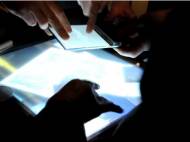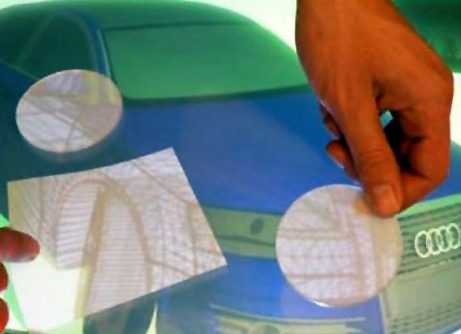Microsoft SecondLight casts second light on information
 The SecondLight technology is going to help us with meta-data in a rather different way from the last article regarding SixthSense. Although often mixed with another Microsoft product called Surface the guys from Redmond clearly stated that SecondLight isn’t a second version of the Microsoft Surface.
The SecondLight technology is going to help us with meta-data in a rather different way from the last article regarding SixthSense. Although often mixed with another Microsoft product called Surface the guys from Redmond clearly stated that SecondLight isn’t a second version of the Microsoft Surface.
This technology allows a second set of images which are invisible to the naked eye, to become visible when a second transparent layer is placed on or above the primary screen. Although very useful along the projector and touch related technologies, Microsoft has announced that it will be at least another two or three years before the Second Light becomes available to the consumer public. The technology works with a primary and secondary projector. It flashes both sets of images at the same time at a rate of about 60 times per second. The second screen is not visible because it is designed to shine through the primary screen and onto either a piece of paper or a transparent surface like a plastic lens or scroll. The second screen can be used to hide specific information until the desired time.
There are many uses of such technology. A teacher can show star charts and have their students search for constellations that become visible when a clear plastic piece is placed above it. Another example is showing the additional meta data related to an image. Overlaying a plainer view of the city streets along with street names or other meta data.
With the projection screen in its diffuse state, SecondLight exhibits the established properties of multi-touch and adding the abilities of second layer surfaces. Aside from allowing an image to be projected on the surface, the diffuser plays a key role in detecting when fingers and other objects which are touching the display or are placed very close to the display. This is an essential feature for direct input surfaces because the interaction relies on robustly detecting touch.
Since the diffuser causes light to scatter, only objects very close to the surface will be clearly imaged and this simplifies touch detection, justifying the need of implementing expensive methods such as stereo vision. It can detect a wide range of objects such as fingers, hands, brushes, game pieces, mobile devices and so forth, and also support the unique identification of objects using retro-reflective markers such as variously shaped prisms.
SecondLight allows the combination of traditional surface interactions with more advanced features that extend interaction beyond the surface. This is made possible because we can project through the display surface, allowing physical objects that have suitable surfaces to be augmented with projections emanating from the SecondLight unit.
Another feature it can provide is the use of “magic lens” a sheet of paper or transparent material which has either passive (retro-reflective) or active (powered infrared LED) tags. If the position of the magic lens is tracked it becomes possible to support more sophisticated interactions. For example, a zoom effect can be applied as the lens is moved towards or away from the surface – making its behavior more corresponding to the real magnifying glass – or new layers of information could be revealed as it rotates. By tracking the position and orientation of a mobile display surface such as a magic lens, it is possible to adjust the projected image in real time so that it appears centered and without any distortion, even as this mobile surface is manipulated in three dimensional space.
Along with the arrival of other new gadgets, the potential of SecondLight is yet to be shown.










Leave your response!